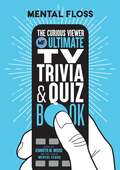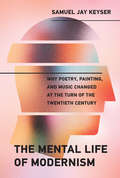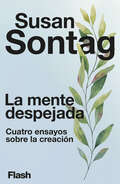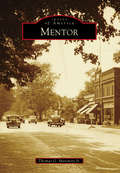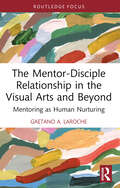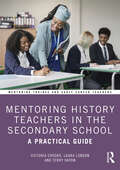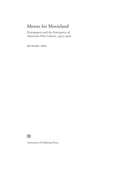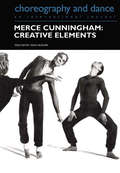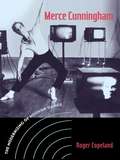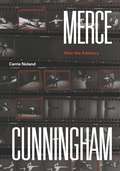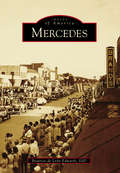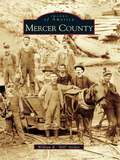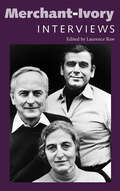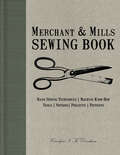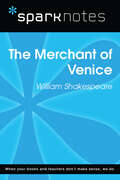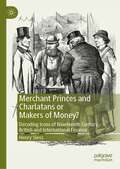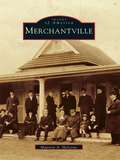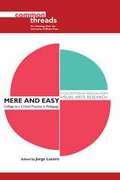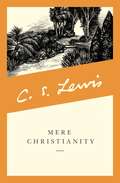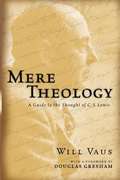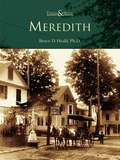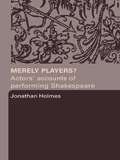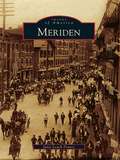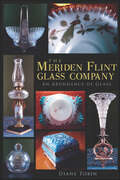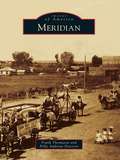- Table View
- List View
Mental Floss: The Curious Viewer Ultimate TV Trivia & Quiz Book
by Mental Floss Jennifer M. WoodImpress your friends, family, and coworkers with fascinating facts about favorite TV shows and test your own TV trivia knowledge with dozens of challenging and entertaining quizzes. Did you know... Succession relies on &“wealth consultants&” to ensure authenticity on how the richest of the rich live? A fan of The Office, after recalling the episode where Steve Carell&’s character arranges a (disastrous) CPR training session, successfully performed CPR on an unconscious stranger? Fraggle Rock was the first American TV series broadcast in Russia? Learn the stories behind these obscure TV tidbits and much more! With fun trivia, challenging quizzes, and log pages for your own lists, Mental Floss: The Curious Viewer Ultimate Quiz and Trivia Book will become as indispensable for your next binge-watch as your remote control. DOZENS OF FUN AND CHALLENGING QUIZZES: Test your TV knowledge with quizzes like "Two Degrees Of" your favorite celebrities, and "Match the Quote to the Simpsons Character" TRIVIA ABOUT MORE THAN 100 TV SHOWS: Get the inside scoop, fascinating facts, and mind-boggling trivia on the greatest shows from the past 20 years, from serious dramas such as Law and Order to seriously funny comedies like Ted Lasso MAKE IT YOUR OWN: Dozens of pages with fill-in lists, such as "Shows I Want to Binge" and "My Favorite TV Quotes" to "Shows I Started but Never Finished" and "My Favorite Shows of All Time."
The Mental Life of Modernism: Why Poetry, Painting, and Music Changed at the Turn of the Twentieth Century
by Samuel Jay KeyserAn argument that Modernism is a cognitive phenomenon rather than a cultural one.At the beginning of the twentieth century, poetry, music, and painting all underwent a sea change. Poetry abandoned rhyme and meter; music ceased to be tonally centered; and painting no longer aimed at faithful representation. These artistic developments have been attributed to cultural factors ranging from the Industrial Revolution and the technical innovation of photography to Freudian psychoanalysis. In this book, Samuel Jay Keyser argues that the stylistic innovations of Western modernism reflect not a cultural shift but a cognitive one. Behind modernism is the same cognitive phenomenon that led to the scientific revolution of the seventeenth century: the brain coming up against its natural limitations. Keyser argues that the transformation in poetry, music, and painting (the so-called sister arts) is the result of the abandonment of a natural aesthetic based on a set of rules shared between artist and audience, and that this is virtually the same cognitive shift that occurred when scientists abandoned the mechanical philosophy of the Galilean revolution. The cultural explanations for Modernism may still be relevant, but they are epiphenomenal rather than causal. Artists felt that traditional forms of art had been exhausted, and they began to resort to private formats—Easter eggs with hidden and often inaccessible meaning. Keyser proposes that when artists discarded their natural rule-governed aesthetic, it marked a cognitive shift; general intelligence took over from hardwired proclivity. Artists used a different part of the brain to create, and audiences were forced to play catch up.
La mente despejada: Cuatro ensayos sobre la creación
by Susan SontagUn cuarteto ensayístico contra la interpretación en el arte. «En lugar de una hermenéutica, necesitamos una erótica del arte». Decía Susan Sontag que el arte ha de ser un acto liberador que permita experimentar la luminosidad del objeto. Interpretarlo, traducirlo, no es más que un acto asfixiante y cobarde. Flash recupera Contra la interpretación, un texto fundamental en la narrativa de la autora, en un momento de actualidad en el que tiene más vigencia que nunca. Y lo acompaña de tres ensayos sobre la creación, Simone Weil, «Los Carnets», de Camus y «Vivre sa vie», de Godard. El resultado es un evocador cuarteto que ofrece a los lectores las claves para guiarse en el mapa de pensamientos de la que ha sido considerada una de las intelectuales más inconformistas del siglo XX. «Los ensayos de Susan Sontag son grandes interpretaciones, incluso acontecimientos, sobre lo que está sucediendo realmente.»Carlos Fuentes «No hay muchas fotografías que valgan más que mil palabras (de Susan Sontag).»Robert Hughes
Mentor
by Thomas G. Matowitz Jr.One of the first towns settled in the lands once known as Connecticut's Western Reserve, Mentor continues to thrive more than two centuries later. After starting out in 1797 as a sparsely populated wilderness outpost with only a handful of permanent residents, Mentor has transformed into a vibrant 21st-century city. The earliest settlers began the great task of felling trees, clearing land, and establishing farms to provide themselves with food and shelter during the area's harsh winters. Through the 19th century, Mentor's growth was slow but steady. Its citizens not only included hardworking farmers and artisans, but wealthy turn-of-the-20th-century Cleveland business leaders, a Civil War Medal of Honor recipient, and the 20th president of the United States, James A. Garfield. Once known for extensive farmland, grand country estates, interurban railroads, and some of the finest nurseries in the country, Mentor is now a diverse community with more than 50,000 residents and a strong and burgeoning local economy.
The Mentor-Disciple Relationship in the Visual Arts and Beyond: Mentoring as Human Nurturing (Routledge Research in Arts Education)
by Gaetano A. LaRocheThis book undertakes a deep examination of mentor and disciple relationships in the development of artists. It draws upon a variety of relationships and models, including an in-person mentor, a mentor or apprentice scenario, and non-physical mentors such as historical figures, in order to investigate their history and philosophy.This volume specifically addresses the role of mentoring in the lives of contemporary aspiring artists, asking if and how mentoring can be considered a form of human nurturance. Deep historical inspections and philosophical inquiries are combined with analyses of interviews with contemporary artists ranging from 35 to 101 years old. These holistic insights present the subject of mentoring in the arts from the multiple angles of art history and relevant ideas about the benefits of nurturance and acceptance in human development.Using artists’ biographies and discussions of their work, this book sheds light on the role that mentoring has played in their development and can play in contemporary education. It will appeal to artists, art history teachers, educators, art students, and art scholars.
Mentoring History Teachers in the Secondary School: A Practical Guide (Mentoring Trainee and Early Career Teachers)
by Victoria Crooks Laura London Terry HaydnMentoring History Teachers in the Secondary School supports mentors to develop the knowledge, skills and understanding essential to the successful mentoring of beginning history teachers who are undertaking their initial teacher training or being inducted into the profession as early career teachers. The authors critically explore models of mentoring and place subject specificity at the heart of every chapter, offering practical mentoring strategies rooted in the best evidence and research from the history teaching community. This book is a vital source of encouragement and inspiration for all those involved in developing the next generation of history teachers, providing accessible summaries of history-specific thinking on a range of topics alongside mentoring support. Key topics include: • Understanding what being a subject-specific mentor of beginning history teachers involves. • Establishing a dialogic mentor-mentee relationship. • Supporting beginning teachers to develop the substantive and disciplinary knowledge they need to become excellent history teachers. • Guiding beginning history teachers through the lesson planning process. • Conducting subject-specific lesson observations and pre- and post-lesson discussions. • Supporting beginning history teachers to consider the purpose of history education and how they can navigate this in relation to values education, the use of ICT, and the teaching of controversial and sensitive issues. Mentoring History Teachers in the Secondary School offers an accessible and practical guide to mentoring beginning history teachers, with ready-to-use strategies to support and inspire both mentors and beginning teachers alike.
Menus for Movieland
by Richard AbelAt the turn of the past century, the main function of a newspaper was to offer "menus" by which readers could make sense of modern life and imagine how to order their daily lives. Among those menus in the mid-1910s were several that mediated the interests of movie manufacturers, distributors, exhibitors, and the rapidly expanding audience of fans. This writing about the movies arguably played a crucial role in the emergence of American popular film culture, negotiating among national, regional, and local interests to shape fans' ephemeral experience of moviegoing, their repeated encounters with the fantasy worlds of "movieland," and their attractions to certain stories and stars. Moreover, many of these weekend pages, daily columns, and film reviews were written and consumed by women, including one teenage girl who compiled a rare surviving set of scrapbooks. Based on extensive original research, Menus for Movieland substantially revises what moviegoing meant in the transition to what we now think of as Hollywood.
Merce Cunningham: Creative Elements (Choreography and Dance Studies Series #Vols. 4, Pts. 2.)
by Joan Acocella David Vaughan Gordon Mumma Thecla Schiphorst William Fetterman Elliot Caplan Marilyn Vaughan Drown John Holzaepfel Nelson RiveraMerce Cunningham reached the age of 75 in 1994, an age at which many creative artists are content to rest on their laurels, or at least to leave behind whatever controversies they may have caused during their careers. No so Cunningham. In the first place, his 70s have been a time of intense creativity in which he has choreographed as many as four new works a year. Cunningham is a strongly committed as ever to the discovery of new ways of moving and of making movement, refusing to be hampered by the physical limitations that have come with age. Since 1991 every new work has been made at least in part with the use of the computer program Life Forms, which enables him to devise choreographic phrases that he himself would be unable to perform - and which challenge and develop the virtuosity of the young dancers in his company.The essays collected in this special issue of Choreography and Dance were written over the last few years and discuss various aspects of the work of Cunningham as seen both from the outside and the inside.
Merce Cunningham: The Modernizing of Modern Dance
by Roger CopelandFirst Published in 2004. Routledge is an imprint of Taylor & Francis, an informa company.
Merce Cunningham: After the Arbitrary
by Carrie NolandOne of the most influential choreographers of the twentieth century, Merce Cunningham is known for introducing chance to dance. Far too often, however, accounts of Cunningham’s work have neglected its full scope, focusing on his collaborations with the visionary composer John Cage or insisting that randomness was the singular goal of his choreography. In this book, the first dedicated to the complete arc of Cunningham’s career, Carrie Noland brings new insight to this transformative artist’s philosophy and work, providing a fresh perspective on his artistic process while exploring aspects of his choreographic practice never studied before. Examining a rich and previously unseen archive that includes photographs, film footage, and unpublished writing by Cunningham, Noland counters prior understandings of Cunningham’s influential embrace of the unintended, demonstrating that Cunningham in fact set limits on the role chance played in his dances. Drawing on Cunningham’s written and performed work, Noland reveals that Cunningham introduced variables before the chance procedure was applied and later shaped and modified the chance results. Chapters explore his relation not only to Cage, but also Marcel Duchamp, Robert Rauschenberg, James Joyce, and Bill T. Jones. Ultimately, Noland shows that Cunningham approached movement as more than “movement in itself,” and that his work enacted archetypal human dramas. This remarkable book will forever change our appreciation of the choreographer’s work and legacy.
Mercedes
by Beatrice de Edwards EdDMercedes is located in Hidalgo County in South Texas in a geographic area called the Lower Rio Grande Valley, which is really a river delta at the mouth of the Rio Grande River first inhabited by Coahuiltecans. Spanish colonists arrived in this area in 1749 to establish ranching communities. In 1905, the American Rio Grande Land and Irrigation Company purchased land in the Llano Grande Spanish land grant, built Mercedes as a showcase headquarters, constructed the largest irrigation system then known, and proceeded to develop the area through commercialized agriculture. Home of notable author Dr. Rolando Hinojosa-Smith, G.I. Forum founder Dr. Hector P. García, Olympic athlete Billy Gene Pemelton, US congressman Rubén Hinojosa, and the Rio Grande Valley Livestock Show, Mercedes continues to attract many visitors who seek the mild climate and warm hospitality of the town.
Mercer County
by William R. ArcherOriginating almost a quarter of a century prior to the Civil War, Mercer County, West Virginia was namedfor General Hugh Mercer, a Revolutionary War hero. The county has been a crossroads for many events, including the Civil War and the establishment of an industrial economy after the war ended. When two mighty railroads, the Norfolk & Western and The Virginian, began shipping coal and timber to the once-agrarian area, Mercer County blossomed into one of the five most highly populated counties of theMountain State. In 1671, colonial explorer Robert Fallam described what would become Mercer County in his journal as "a pleasing tho' dreadful sight to see the mountains and hills as if piled one upon another." Despite extreme challenges, residents ofMercer County developed a spirit of pride, independence, strength, and genuine fellowship that today makes the region a warm and friendly place to call home. As legend holds, even the notorious outlaw Frank James was so overwhelmed by the hospitality he received in Mercer County in 1882 thathe decided to pass on robbing the Bank of Princeton and, instead, robbed a bank in a neighboring county.
Merchant-Ivory: Interviews (Conversations with Filmmakers Series)
by Laurence RawMerchant-Ivory: Interviews gathers together, for the first time, interviews made over a span of fifty years with director James Ivory (b. 1928), producer Ismail Merchant (1936–2005), and screenwriter Ruth Prawer Jhabvala (1927–2013). Beginning with their earliest work in India, and ending with James Ivory's last film, The City of Your Final Destination (2009), the book traces their career, while offering valuable insights into their creative filmmaking process. The volume serves as a corrective to the prevailing critical orthodoxy attached to Merchant-Ivory's work, which tends to regard them as being solely concerned with historically accurate costumes and settings. As independent filmmakers, they have developed an idiosyncratic approach that resists facile classification. Merchant-Ivory have insisted on maintaining their independence. More importantly, this book shows how Merchant-Ivory have always taken considerable care in casting their films, as well as treating actors with respect. This is a deliberate policy, designed to bring out one of the triumvirate's principal thematic concerns, running throughout their work—the impact of the “clash of cultures” on individuals. Partly this has been inspired by their collective experiences of living and working in different cultures. They do not offer any answers to this issue; rather they believe that their task is simply to raise awareness; to make filmgoers conscious of the importance of cultural sensitivities that assume paramount significance in any exchange, whether verbal or nonverbal.
Merchant & Mills Sewing Book: Hand Sewing Techniques / Machine Know-How / Tools / Notions / Projects / Patterns
by Carolyn N.K. DenhamWith an emphasis on quality materials, careful craftsmanship, and simplicity, Merchant & Mills Sewing Book presents 15 functional, beautiful projects. Crafters and aspiring designers will master hand- and machine-sewing techniques, learn about fundamental tools and materials, and improve their tailoring skills before sewing timeless projects such as a maker's apron, bolster cushion, flight bag, classic shirt, and more. Reflecting the distinctive utilitarian style of Merchant & Mills, this book reminds readers to keep it simple and do it well, and makes a handsome addition to any craft library.
The Merchant of Venice (SparkNotes Literature Guide Series)
by SparkNotesThe Merchant of Venice (SparkNotes Literature Guide) by William Shakespeare Making the reading experience fun! Created by Harvard students for students everywhere, SparkNotes is a new breed of study guide: smarter, better, faster. Geared to what today's students need to know, SparkNotes provides: *Chapter-by-chapter analysis *Explanations of key themes, motifs, and symbols *A review quiz and essay topicsLively and accessible, these guides are perfect for late-night studying and writing papers
Merchant Princes and Charlatans or Makers of Money?: Decoding Icons of Nineteenth Century British and International Finance
by Henry SlessThis book provides a critical analysis of visual images of British and international finance during the nineteenth century. Its focus is on the financiers themselves, contrasting the depiction of the respectable Merchant Princes with the less than perfect charlatans (white-collar criminals) who defrauded investors of millions. The breakdown of trust between financiers and investors that evolved during this period is represented visually in depictions of the emotional response of investors to the uncertain financial climate.Throughout the book a PEARL methodology has been used to critique the images reflecting the impact of any Publisher’s political bias, the Editorial and Artistic techniques used to convey the messages in the images, and the Legal context (especially a concern in countries such as France and Germany where censorship was strict).The book concludes that white-collar criminals were invariably secretly admired in Britain, and rarely severely satirised. Similarly, Merchant Princes were depicted favourably in Britain as members of the ruling elite during the latter half of the century. This is contrasted with the more extreme anti-monopolistic images in the US and the extreme anti-Semitic treatment of Jewish financiers in France and Germany.
Merchantville (Images of America)
by Maureen A. MclooneOne hundred feet above the Delaware River is Merchantville, a spirited community founded in 1874. Many wealthy Philadelphia merchants established residences while others summered in this key South Jersey center for goods and services. In 1926, the building of the Benjamin Franklin Bridge opened the door to a new era of expansion, which continues today, as Merchantville forges ahead on its prosperous path. A sign of Merchantville's past and a crowning jewel of today is the wonderful Victorian architecture seen throughout town. Many historical homes still stand, lovingly restored and maintained by enthusiastic, caring residents. Merchantville includes a look at these great homes, as well as a chronicle of the town's greatest asset, its people. Boxing champion Jersey Joe Walcott, born in 1914 in Merchantville, trained right in the center of town; Jane Eayre Fryer wrote the Mary Frances series for young girls (1911-1918); and Wallis Warfield Simpson, later the Duchess of Windsor, visited Merchantville c. 1900. But everyday life and everyday residents are what make any study of history vital, and they are what make Merchantville so outstanding.
Mere and Easy: Collage as a Critical Practice in Pedagogy
by Jorge LuceroCollage making offers everyone from small children to trained artists the ability to express themselves through images. In this new Common Threads collection, Jorge Lucero draws on the archive of the journal Visual Arts Research to present articles focused on the place of collage in fine art and education. Guided by the twinned concepts of mereness --collage's reputation as a trifle--and easiness --the technique's accessibility to all--the authors explore how subversive, debased, and effortless the collage gesture can be. What emerges is in and of itself a collage, one that groups disparate scholarship into a whole that reveals how the technique may serve as a method of scholarship and as a wellspring of vibrant, even radical, pedagogical utility. Contributors: Michael Biggs, Ian Buchanan, Daniela Büchler, Paul Duncum, Charles R. Garoian, Kit Grauer, Anniina Suominen Guyas, Kathleen Keys, Jorge Lucero, Dan Nadaner, Ryan Patton, Janet N. Stevenson, Robert W. Sweeny, and Stuart Thompson.
Mere Christianity
by C. S. LewisA forceful and accessible discussion of Christian belief that has become one of the most popular introductions to Christianity and one of the most popular of Lewis's books. Uncovers common ground upon which all Christians can stand together.
Mere Theology: A Guide to the Thought of C. S. Lewis
by Will VausWhat did C. S. Lewis believe about God, Jesus Christ, the Holy Spirit, heaven, hell, creation, the Fall, the forgiveness of sins, marriage and divorce, war and peace, the church and sacraments, masculinity and femininity? Lewis was not a professional theologian, but anyone who has read his writings--whether fiction or nonfiction, essays or correspondence--knows that profoundly Christian convictions permeate them all. The more one reads, the more it becomes clear that Lewis could write with charity and simplicity while preserving theological accuracy because he was well informed and thoroughly grounded in the Christian faith. Will Vaus has masterfully brought together Lewis's thought from throughout his voluminous writings to provide us a full-orbed look into his beliefs on twenty-five Christian themes. This book gives us not only a comprehensive view of Lewis's theological convictions but also guidance and encouragement for our own spiritual journeys toward the God whom Lewis found so real, personal and present. Introduction by Douglas Gresham.
Meredith
by Bruce D. HealdThe history of Meredith as a corporate town dates back more than two hundred thirty years. Like most older towns, especially those devoted largely to agriculture, Meredith has greatly diminished in territory since its original incorporation; unlike most New Hampshire towns of this size, however, it is progressive and prosperous, and the valuation of the town has steadily increased. This growth is the result of Meredith's change from an agricultural town to an industrial town to today's prosperous four-season resort in the heart of the Lakes Region, at the foothills of the White Mountains. Meredith, part of the Then & Now series, places vintage images alongside contemporary photographs, taken by photographer Aaron Ober, to show the changes that have taken place in this area through the years.
Merely Players?: Actors' Accounts of Performing Shakespeare
by Jonathan HolmesMerely Players? marks a groundbreaking departure in Shakespeare studies by giving direct voice to the Shakespearean performer. It draws on three centuries worth of actors' written reflections on playing Shakespeare and brings together the dual worlds of performance and academia, providing a unique resource for the student and theatre-lover alike.
Meriden
by Janis Leach FrancoIncorporated in 1806, Meriden was once proposed as the state capital. Although the plan was not implemented, the rural village quickly burgeoned into a major manufacturing center with the advent of the industrial revolution. Meriden advanced to become renowned as the "Silver City." International Silver Company and other key businesses, such as Parker Gun, Manning Bowman, Wilcox and White, and Handel Lamp, made Meriden a familiar name. Home to Gov. Abiram Chamberlain, Arctic explorer Hugh Johnson Lee, opera diva Rosa Ponselle, and baseball's Connie Mack, the city has also long been enlivened by a diverse mixture of immigrants and newcomers. Bordered on the north by dramatic traprock ridges, Meriden has a larger percentage of parklands than any other town in Connecticut, with Hubbard Park its crowning jewel.
The Meriden Flint Glass Company: An Abundance of Glass
by Diane TobinFounded in 1876, the Meriden Flint Glass Company produced internationally renowned glass that adorned ornate lanterns, jewelry boxes, vases and many other intricate pieces. Although it was only in operation for a brief time, the company remains an important landmark in Meriden, Connecticut, as well as in the history of the American glassmaking industry. Author Diane Tobin details the history of the company, drawing on extensive sources ranging from local Meriden papers to the personal diary of the company's intrepid leader, Joseph Bourne. Fascinating insights into how the famous glass was made, the role the company played in early labor movements and the growth of Meriden alongside it round out this exciting history of the Meriden Flint Glass Company.
Meridian
by Frank Thomason Polly Ambrose PetersonEight miles west of Idaho's capital city, Boise, the first settlers in what became Meridian found only arid land, sagebrush, and jackrabbits. The lone tree in the area was another 8 miles west in what became Nampa. Originally called Hunter, after a railroad superintendent, Meridian was initially a railway postal drop where workers tossed and hooked mailbags as the train passed through before the arrival of passenger service. By 1893, residents called the village Meridian, after the north-south prime meridian running through Meridian Road. In 1903, the village incorporated but still had a population of only a few hundred with grocery and harness shops and more churches than saloons. Village merchants and residents experienced orchard and dairy/creamery eras that ended in, respectively, the 1940s and 1970. Meridian became a city in the 1940s but 50 years later had a population of only 10,000. That number quadrupled over the next decade and today has nearly doubled again to around 80,000, as Meridian has evolved into the transportation and commercial hub of the Treasure Valley, especially in electronics and health care.
